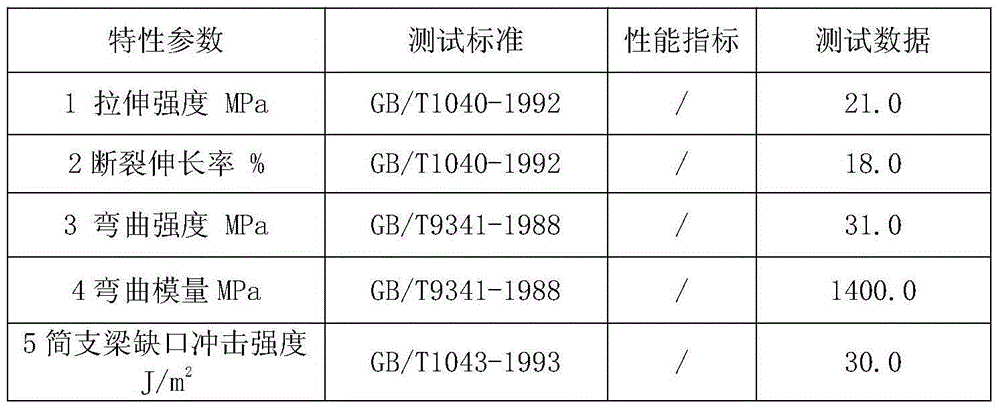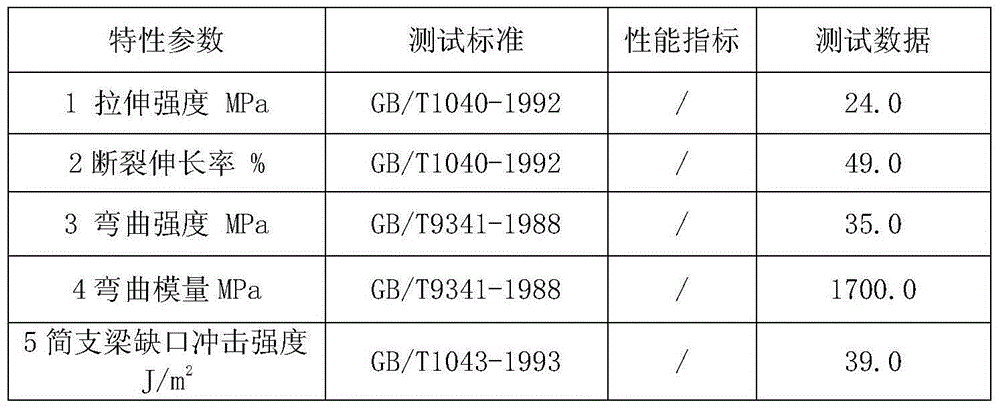Hollow glass micro-bead reinforced polypropylene material
A technology of hollow glass microspheres and polypropylene materials, applied in the field of polypropylene material production, can solve problems such as poor creep resistance, variability, and large shrinkage
- Summary
- Abstract
- Description
- Claims
- Application Information
AI Technical Summary
Problems solved by technology
Method used
Image
Examples
Embodiment 1
[0014] (1) Take each raw material respectively by weight ratio as follows:
[0015] Polypropylene: 70;
[0016] Silane coupling agent: 1.0;
[0017] Antioxidant: 1.0;
[0018] Hollow glass microspheres: 10;
[0019] Dispersed lubricant: 0.5;
[0020] Dispersant: 0.5.
[0021] (2) First surface activate the hollow glass microspheres and silane coupling agent, then dry mix the above-mentioned various raw materials in a high-speed mixer for 3-5 minutes, and then put them in a twin-screw extruder for melt extrusion , cooling, pelletizing, and packaging the finished product; among them, the temperature of the first zone of the twin-screw extruder is 90-100°C, the second zone is 150-180°C, the third zone is 200-210°C, and the fourth zone is 200-205°C ; The fifth zone is 190-200°C, the residence time is 1-2 minutes, and the pressure is 10-15Mpa.
[0022] Experimental results
[0023]
Embodiment 2
[0025] (1) Take each raw material respectively by weight ratio as follows:
[0026] Polypropylene: 75;
[0027] Silane coupling agent: 2.0;
[0028] Antioxidant: 2.0;
[0029] Hollow glass microspheres: 20;
[0030] Dispersed Lubricant: 1.0;
[0031] White oil: 1.0.
[0032] (2) First surface activate the hollow glass microspheres and silane coupling agent, then dry mix the above-mentioned various raw materials in a high-speed mixer for 3-5 minutes, and then put them in a twin-screw extruder for melt extrusion , cooling, pelletizing, and packaging the finished product; among them, the temperature of the first zone of the twin-screw extruder is 90-100°C, the second zone is 150-180°C, the third zone is 200-210°C, and the fourth zone is 200-205°C ; The fifth zone is 190-200°C, the residence time is 1-2 minutes, and the pressure is 10-15Mpa.
[0033] Experimental results
[0034]
Embodiment 3
[0036] (1) Take each raw material respectively by weight ratio as follows:
[0037] Polypropylene: 80;
[0038] Silane coupling agent: 3.0;
[0039] Antioxidant: 3.0;
[0040] Hollow glass microspheres: 30;
[0041] Dispersed lubricant: 1.5;
[0042] Dispersant: 1.5.
[0043] (2) First surface activate the hollow glass microspheres and silane coupling agent, then dry mix the above-mentioned various raw materials in a high-speed mixer for 3-5 minutes, and then put them in a twin-screw extruder for melt extrusion , cooling, pelletizing, and packaging the finished product; among them, the temperature of the first zone of the twin-screw extruder is 90-100°C, the second zone is 150-180°C, the third zone is 200-210°C, and the fourth zone is 200-205°C ; The fifth zone is 190-200°C, the residence time is 1-2 minutes, and the pressure is 10-15Mpa.
[0044] Experimental results
[0045]
PUM
 Login to View More
Login to View More Abstract
Description
Claims
Application Information
 Login to View More
Login to View More - R&D
- Intellectual Property
- Life Sciences
- Materials
- Tech Scout
- Unparalleled Data Quality
- Higher Quality Content
- 60% Fewer Hallucinations
Browse by: Latest US Patents, China's latest patents, Technical Efficacy Thesaurus, Application Domain, Technology Topic, Popular Technical Reports.
© 2025 PatSnap. All rights reserved.Legal|Privacy policy|Modern Slavery Act Transparency Statement|Sitemap|About US| Contact US: help@patsnap.com



